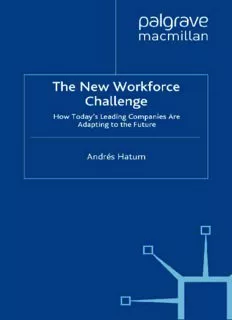
The New Workforce Challenge: How Today’s Leading Companies Are Adapting to the Future PDF
Preview The New Workforce Challenge: How Today’s Leading Companies Are Adapting to the Future
The New Workforce Challenge This page intentionally left blank The New Workforce Challenge How Today’s Leading Companies Are Adapting to the Future Andrés Hatum © Andrés Hatum 2013 Softcover reprint of the hardcover 1st edition 2013 978-1-137-30298-4 All rights reserved. No reproduction, copy or transmission of this publication may be made without written permission. No portion of this publication may be reproduced, copied or transmitted save with written permission or in accordance with the provisions of the Copyright, Designs and Patents Act 1988, or under the terms of any licence permitting limited copying issued by the Copyright Licensing Agency, Saffron House, 6–10 Kirby Street, London EC1N 8TS. Any person who does any unauthorized act in relation to this publication may be liable to criminal prosecution and civil claims for damages. The author has asserted his right to be identifi ed as the author of this work in accordance with the Copyright, Designs and Patents Act 1988. First published 2013 by PALGRAVE MACMILLAN Palgrave Macmillan in the UK is an imprint of Macmillan Publishers Limited, registered in England, company number 785998, of Houndmills, Basingstoke, Hampshire RG21 6XS. Palgrave Macmillan in the US is a division of St Martin’s Press LLC, 175 Fifth Avenue, New York, NY 10010. Palgrave Macmillan is the global academic imprint of the above companies and has companies and representatives throughout the world. Palgrave® and Macmillan® are registered trademarks in the United States, the United Kingdom, Europe and other countries. ISBN 978-1-349-45403-7 ISBN 978-1-137-30299-1 (eBook) DOI 10.1057/9781137302991 This book is printed on paper suitable for recycling and made from fully managed and sustained forest sources. Logging, pulping and manufacturing processes are expected to conform to the environmental regulations of the country of origin. A catalogue record for this book is available from the British Library. A catalog record for this book is available from the Library of Congress. 10 9 8 7 6 5 4 3 2 1 22 21 20 19 18 17 16 15 14 13 Contents Figures and Tables vii Acknowledgments xi Introduction 1 1 Organizing and the New Agile and Virtual Firm 11 New Ways of Organizing: The Rise of Complexity 11 The Agile and Virtual Firm 21 Case in Point: Open Business Model at elBulli 31 2 Demographic Changes in the Workplace 35 Different Generations and Perspectives 35 The Millennial Generation: “We Are Going to Rock the Workplace” 43 Are Generations Similar Worldwide? India, China and the West 50 Case in Point: Frisse Blikken (Fresh Forces), New Organizational Paradigms for New Talent 58 3 Attracting Millennials to the Workplace 63 Building the Employee Value Proposition (EVP) to Attract Millennials 63 New Ways of Recruiting: The Role of Social Networks 81 vi Contents Case in Point: “Reveal” by L’Oréal, Attracting Millennials and Guiding Them into the Workplace 95 4 New Learning Paradigms and the Challenge of Developing the Future Leaders 99 The New Paradigms of Learning 99 Developing the Next Generation of Leaders 112 Topsy Turvy: Careers Reloaded 127 Case in Point: La Masía–Barcelona Club – A Talent Development School for the Future 141 5 The New Realignment Contract 145 In Search of … Agility 145 Concluding Remarks 161 Interviews 165 Notes 169 Bibliography 183 Index of Companies and Organizations 193 Subject Index 195 Figures and Tables Figures 1.1 Business model at Wikipedia 15 1.2 Business model at Threadless.com 15 1.3 Features of an agile and virtual organization 26 1.4 Open business model at elBulli 33 2.1 Millennials in the agile and virtual fi rm 44 2.2 Organizational scope over time and across generations 49 3.1 Deloitte’s Leadership Academy 73 3.2 Faster, freer and further: EVP at Coty 76 3.3 Getting strategic about attracting Millennials: Recruiting process at Sodexo 85 3.4 Finding the right set of benefi ts for each generation 88 4.1 Learning strategy matrix 106 4.2 Learning experience for Millennials 111 4.3 Leaders of the future 114 4.4 Development activities according to their learning and collaboration impact 119 4.5 Developing managerial and interpersonal competencies 120 4.6 An example of a career ladder 129 4.7 An approach toward a customized portfolio career (CPC): Richard’s case 136 viii Figures and Tables 4.8 An approach toward a CPC: Anika’s case 137 4.9 An integrated process: Developing talent at FC Barcelona 144 5.1 7-S framework (based on Peters and Waterman, 1982) 146 5.2 Nine elements of organizational health (based on Keller and Price, 2011) 148 5.3 A model of organizational agility 149 5.4 Creating scenarios to anticipate the future (based on Butterfi eld, 2006) 152 5.5 Aligning the organization and the new HR paradigm 155 5.6 Natura’s alignment model 155 5.7 A model of change and stability for the future organization 159 5.8 A model of organizing for the future workplace and workforce 161 Tables I.1 Practices, processes and organizations (relevant examples) 5 I.2 Cases in point 7 1.1 Evolution of organizations over time and technological revolution 18 1.2 Properties associated with agile and virtual fi rms 27 2.1 Main features throughout different generations 39 2.2 Inside the different generations: The differences 40 2.3 Implications of Millennials’ characteristics 48 3.1 EVP dimensions supporting Millennials’ characteristics 75 4.1 Millennials’ characteristics and the learning process 103 Figures and Tables ix 4.2 Future leadership competencies 116 4.3 Managerial competencies and Millennials’ characteristics 123 4.5 Millennials’ characteristics and implications for careers and organizations 132
Description: